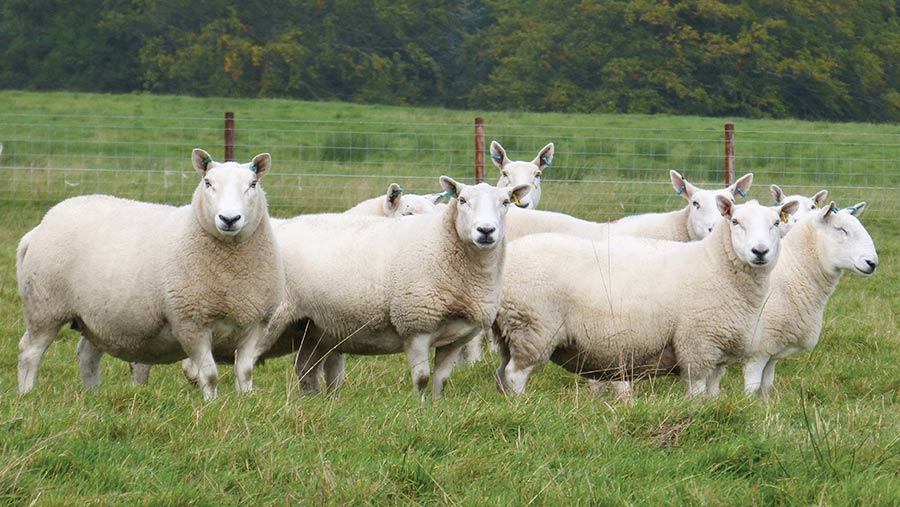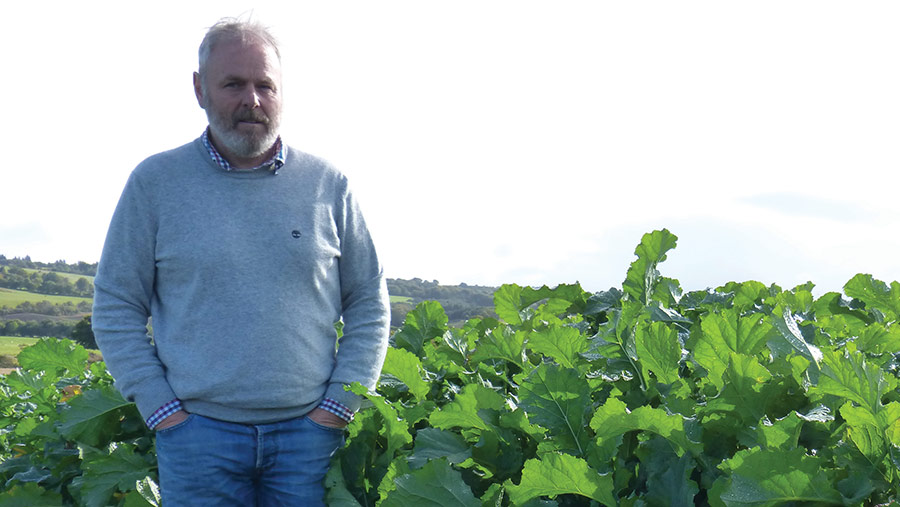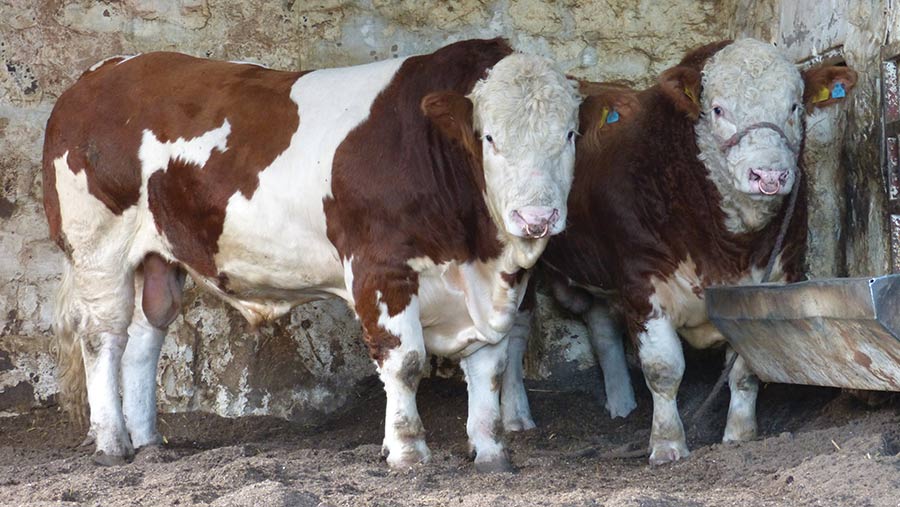Forage crop nets £20 a ewe saving for Lothian flock
 © MAG/Michael Priestley
© MAG/Michael Priestley A West Lothian farm is increasing its forage acreage this autumn after saving more than £16,000 by finishing lambs and wintering ewes on a brassica last winter.
Farmer Richard McCulloch has cut more than £20,000 of cake inputs from his 850-head lowland sheep enterprise, near Bathgate, by winter grazing on Redstart, a rape/kale hybrid.
After establishment costs, this has left the enterprise £16,400 better off. This saving, of almost £20 a ewe, has made sheep the best earner on the farm.
See also: Forage crops helps add value to Scots beef and sheep farm
“We’ve turned a massive corner and it’s taken the sheep from breakeven to making good money,” says Richard.
The decision to grow crops in summer 2022 was made in time to shield him from cereal price rises and avoid paying £350/t for hard feed.
Farm facts: Overhill House

Richard McCulloch © MAG/Michael Priestley
- 850 commercial ewes in stratified system
- Draft North Country Cheviots and Scottish blackface bought in
- Home-bred Cheviot Mules used
- 135 pure Simmental herd
- Farming 480ha, of which 80ha rented
- 60ha of winter and spring barley, mostly for home use
- Lambs sold through United Auctions (Stirling) and Scotbeef
- 200kW biomass boiler
Making a good margin is important to Richard, who runs several businesses alongside the Overhill House farming enterprise.
These include UK-wide demolition company Dem-Master, a waste business, a power plant, and a property business, with 180 employees and a further 20 or so contractors.
Daily tasks and responsibilities are often delegated to two full-time farm stockmen and a part-time self-employed shepherd, with Richard filling in on evenings and at weekends.
Sheep flock development
Richard’s sheep system has evolved as he has acquired ground. In the 1990s, he started by securing 16ha (40 acres) of rough grazing outside Armadale, which was used to develop property.
By 2004, he had 100ha (247 acres), having moved to Overhill House and begun breeding Simmentals. Now he owns close to 400ha (1,000 acres) across four blocks and two steadings to the north and west of Bathgate.
Historically, store lambs were bought each year at the Lairg sale, with about 1,000 finished annually on grass and hoppers.
By selecting the best gimmers to run with a tup, a new breeding flock was gradually established, before Richard started buying breeding ewes in 2012.
He buys North Country Cheviot and Scottish Blackface drafts in each year and uses a crossing-type Bluefaced Leicester to breed Mules. Texels are used as terminal sires to produce commercial prime lambs.
Cutting out cake and running a more forage-based system should bring an added benefit of challenging home-bred flock genetics to thrive and flesh better on forage, he says.

© MAG/Michael Priestley
Simmental success
The fact the sheep are now netting the biggest margin from the 1,300 lambs sold each year is no mean feat, given the recent achievements of the Overhill House Simmental herd.
The herd set a new May sale top price record at Stirling when it saw a 16,000gns bid for overall championship-winning bull Overhill House Neil.
This was followed by an overall championship win with Overhill House McCoy, which sold for 10,000gns at Carlisle.
“The cattle are an efficient business, but the sheep don’t have the input costs of buying elite breeding cattle or the time associated with sale preparation,” says Richard.
“Bulls yield a 410kg carcass at 14 months of age and left a gross margin of £800 this past year, but keeping a cow costs most of that.”
More forage
Rising feed costs made Richard look at an alternative to concentrates, and he was convinced by Germinal to try Redstart (see “First year growing a rape/kale hybrid at Overhill House”).
He chose the crop because of its feed value – often 12-13MJ/kg metabolisable energy and more than 20% crude protein.
Having a cheap, high-energy feed is ideal for keeping energy levels up in the ewes before a tight lambing period, he says.
A teaser has been used in recent years, meaning up to 650 head can lamb in the first 10 days.
“We’ve grown some really impressive crops. It’s big and tall and it has proved hardy,” he says.
“We can grow it across the farm, and it’s done fine on heavier land and the lighter land.
Once establishment costs have been factored in, the overall savings amount to £16,000. There are some [associated] labour costs too, but ‘snackering’ and checking stock takes time anyway.”
Cutting costs
Finishing lambs used to require up to 40t of lamb finisher pellets (5t of concentrate feed for eight weeks) in the autumn.
Since introducing the rape/kale hybrid to their ration, only 100 stragglers are given cake to help them finish late in the year.
Similarly, the ewes grazed on grass and were fed ewe rolls with a snacker once grass covers became limited in November and December.
Now, twin- and triplet-bearing ewes are fed cake for only six weeks before lambing starts on 12 April, typically saving 24t of cake.
In total, at an average cost of £350/t, the money saved last winter was about £14,000 on the lambs and £8,400 on the ewes.
Ewe rolls and energy licks continue to be used in the spring around a hybrid, indoor/outdoor lambing season that is shortened with teasers. The rolls supplement haylage fed inside.
Winter plans
Winter forage crop acreage has doubled this year. About 12ha (30 acres) of stubble turnips have been drilled, as well as 12ha (30 acres) of Redstart.
Richard hopes this will allow the team to delay putting sheep on grass for longer and keep bought-in feed costs down.
Doing this will leave more grass for lambing paddocks in the spring.
“We will look at using the kale hybrid after winter barley or a tired grass ley to improve the farm and soil fertility,” he says.
First year growing a rape/kale hybrid at Overhill House
Establishment
Richard McCulloch prepared about 13.5ha (33 acres) following the winter barley harvest in July 2022, mostly by ploughing, power harrowing and rolling with a heavy roller.
The Redstart was then drilled and followed by a pass with a Cambridge roll.
Fuel, seed, tractor use and time cost about £4,950, and £1,050 was spent on fertiliser, giving a total cost of £6,000 for establishment.
Field selection
A block of arable fields was used to grow the Redstart.
This meant there was an adjacent field of barley stubbles to use as a runback, giving sheep a dry lie and stubble to graze.
The crops were subdivided into four equal sections, which was a compromise between using enough of the crop and time spent fencing and moving sheep, says Richard.
Water was supplied via two concrete troughs halfway along the perimeter of each field on opposing sides.
Fields could be quartered by running the fence line up to the trough.
Grazing
Vigorous summer growth and a resistance to bolting means quality is maintained between a July sowing and lambs grazing the Redstart in October and November.
Ewes grazed the crop from Christmas to late March. The plant can grow 0.9-1m high, so a front flail mower was used to cut paths in the crop so fences could be easily erected.
